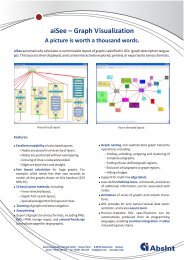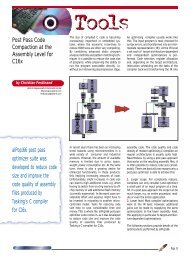Worst-Case Execution Time Prediction by Static Program ... - Absint
Worst-Case Execution Time Prediction by Static Program ... - Absint
Worst-Case Execution Time Prediction by Static Program ... - Absint
You also want an ePaper? Increase the reach of your titles
YUMPU automatically turns print PDFs into web optimized ePapers that Google loves.
• Path Analysis determines a worst-case execution path of the program [13].<br />
Cache Analysis uses the results of value analysis to predict the behavior of the (data) cache. The results of cache<br />
analysis are used within pipeline analysis allowing the prediction of pipeline stalls due to cache misses. The<br />
combined results of the cache and pipeline analyses are the basis for computing the execution times of program<br />
paths. Separating WCET determination into several phases makes it possible to use different methods tailored to<br />
the subtasks [13]. Value analysis, cache analysis, and pipeline analysis are done <strong>by</strong> abstract interpretation [2], a<br />
semantics-based method for static program analysis. Integer linear programming is used for path analysis.<br />
3.1 Reconstruction of the Control Flow from Binary <strong>Program</strong>s<br />
The starting point of our analysis framework (see Figure 1) is a binary program and a so-called AIS file containing<br />
additional user-provided information about numbers of loop iterations, upper bounds for recursion, etc. (see<br />
section 4).<br />
In the first step a parser reads the executable and reconstructs the control flow [11, 12]. This requires some knowledge<br />
about the underlying hardware, e.g., which instructions represent branches or calls. The reconstructed control<br />
flow is annotated with the information needed <strong>by</strong> subsequent analyses and then translated into CRL (Control Flow<br />
Representation Language)—a human-readable intermediate format designed to simplify analysis and optimization<br />
at the executable/assembly level. This annotated control-flow graph serves as the input for micro-architecture<br />
analysis.<br />
The decoder can find the target addresses of absolute and pc-relative calls and branches, but may have difficulties<br />
with target addresses computed from register contents. Thus, aiT uses specialized decoders that are adapted to certain<br />
code generators and/or compilers. They usually can recognize branches to a previously stored return address,<br />
and know the typical compiler-generated patterns of branches via switch tables. Yet non-trivial applications may<br />
still contain some computed calls and branches (in hand-written assembly code) that cannot be resolved <strong>by</strong> the<br />
decoder; these unresolved computed calls and branches are documented <strong>by</strong> appropriate messages and require user<br />
annotations (see section 4). Such annotations may list the possible targets of computed calls and branches, or tell<br />
the decoder about the address and format of an array of function pointers or a switch table used in the computed<br />
call or branch.<br />
3.2 Value Analysis<br />
Value analysis tries to determine the values in the processor registers for every program point and execution context.<br />
Often it cannot determine these values exactly, but only finds safe lower and upper bounds, i.e. intervals that are<br />
guaranteed to contain the exact values. The results of value analysis are used to determine possible accesses of<br />
indirect memory accesses—important for cache analysis—and in loop bound analysis (see section 3.3).<br />
Value analysis uses the framework of abstract interpretation [2]: an abstract state maps registers to intervals of<br />
possible values. Each machine instruction is modeled <strong>by</strong> a transfer function mapping input states to output states<br />
in a way that is compatible with the semantics of the instruction. At control-flow joins, the incoming abstract states<br />
are combined into a single outgoing state using a combination function. Because of the presence of loops, transfer<br />
and combination functions must be applied repeatedly until the system of abstract states stabilizes. Termination of<br />
this fixed-point iteration is ensured on a theoretical level <strong>by</strong> the monotonicity of transfer and combination functions<br />
and the fact that a register can only hold finitely many different values. Practically, value analysis becomes only<br />
efficient <strong>by</strong> applying suitable widening and narrowing operators as proposed in [2]. The results of value analysis<br />
are usually so good that only a few indirect accesses cannot be determined exactly. Address ranges for these<br />
accesses may be provided <strong>by</strong> user annotations.<br />
3.3 Loop Bound Analysis<br />
WCET analysis requires that upper bounds for the iteration numbers of all loops be known. aiT tries to determine<br />
the number of loop iterations <strong>by</strong> loop bound analysis, but succeeds in doing so for simple loops only. Bounds for<br />
the iteration numbers of the remaining loops must be provided as user annotations (see section 4).<br />
Loop bound analysis relies on a combination of value analysis (see section 3.2) and pattern matching, which<br />
looks for typical loop patterns. In general, these loop patterns depend on the code generator and/or compiler used





